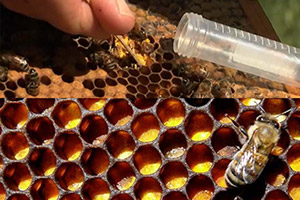
Over 3,000 entomologists and insect scientists from around the world descended on Minneapolis, MN to participate in the 63rd Annual Meeting of the Entomological Society of America (ESA). The four day Synergy in Science conference ran from November 15th-18th, 2015. Bright and early on Sunday morning honey bee researchers convened in the convention center to kick off the event with a member organized symposium entitled “Colony Collapse Disorder Eight Years Later: What We Know Now That We Didn’t Know Then.”
Organized by Richard Levine, public affairs officer for ESA, and Dennis vanEngelsdorp from the University of Maryland, the program focused on the issues impacting honey bee health today. Initially the team planned to invite the exact same line-up of speakers that presented at the original CCD symposium hosted at ESA in 2007. The original event hosted by Diana Cox-Foster and Jeff Pettis was a late-breaking symposium added to the schedule only two months before the conference took place in December in San Diego, CA. Entitled “Colony Collapse Disorder in Honey Bees: Insight Into Status, Potential Causes, and Preventive Measures” it explored possible factors causing honey bee deaths since 2006, such as pathogens, parasites, viruses, bacteria, disease, pesticide exposure, and breeding practices. It also aimed to dispel some of the myths and mysteries of CCD, along with potential methods to lower colony losses.
Many of the presenters and authors from that first conference spoke this year, including May Berenbaum, Marla Spivak, David Tarpy, and Dennis vanEngelsdorp, along with several newcomers. The four hour event started at 8 am, when 140 people crowded into the room to hear May Berenbaum. She gave a whirlwind talk that attempted to cover the 584 scientific papers that have been published on CCD in the 16 minutes allotted. Berenbaum spoke at high speed and non-stop, barely pausing to take a breath between presentation slides. With a touch of humor, she plowed through the long list of improbable causes and a much shorter list of probable ones she had compiled back in 2007. The only one kicked off the list for certain: “Osama bin Laden.”
She flashed paper headlines up onto the screen, such as a September 2007 report published in Science that found “one organism, Israeli acute paralysis virus (IAPV) of bees, was strongly correlated with CCD.” This was quickly followed up with another study published in ABJ that showed IAPV was in the USA since at least 2002, long prior to CCD. Scientists thought perhaps the losses were due to the recently introduced pesticide class neonicotinoids, especially imidacloprid which had been blamed for “Mad bee disease” in Europe. But the 2010 paper by Mullin et al. demonstrated only 2 of 208 wax samples (1%), 10 of 350 pollen samples (2.9%) and zero bee samples were contaminated with imidacloprid.
Frustrating? Yes! Incorrect? No. Berenbaum’s talk highlighted that the answers are never quite as clear as we initially think. This sifting through material, running experiments, testing hypotheses, finding possible causes and then running further tests to clarify the results is exactly how science works. Many conclusions initially drawn later prove to be wrong. We take three steps forward and two steps back. That’s just how science works. It isn’t fast, but it often does get there eventually with each new experiment building on the work of prior experiments. Only through replication and finding the same outcomes again and again does theory slowly become fact.
VanEngelsdorp followed up with his talk “Varroa: The monster in our midst.” He too hit at the idea that answers aren’t evident, starting off with a quote from H.L Mencken. “For every complex problem there is an answer that is clear, simple, and wrong.” There are no easy answers. High honey bee losses continue, but no single factor leads the charge. Instead varroa, pesticides and nutrition interact, a careful balancing act that may easily be perturbed. Honey bees can no longer tolerate the high levels of varroa they did in the past. The economic threshold when colonies start to experience negative impacts from varroa has sunk. The majority of the mites hide in the brood nest, leaving only 20% of the varroa population on adult bees. If a colony has 20,000 bees, 80% of the mites are hidden out of sight. So when a beekeeper does an alcohol or sugar shake and finds 4 mites per 100 bees, it indicates a total population of 4,000 mites in the colony.
According to vanEngelsdorp, natural varroa mite reproduction suggests that most colonies will have 0.2 mites per 100 bees in June, a number that rises to 4 in August and 6.6 by October, just due to natural ebbs and flows in the honey bee and varroa mite population. But many of the samples from the National Honey Bee Disease Survey show 10+ varroa mite levels in August through November. So what’s going on?
A nuclear bomb exploded on the screen behind Dennis. Colonies unmanaged for varroa populations collapse. They act like nuclear bombs in the environment, according to Dennis. Healthy bees come in and rob out …


